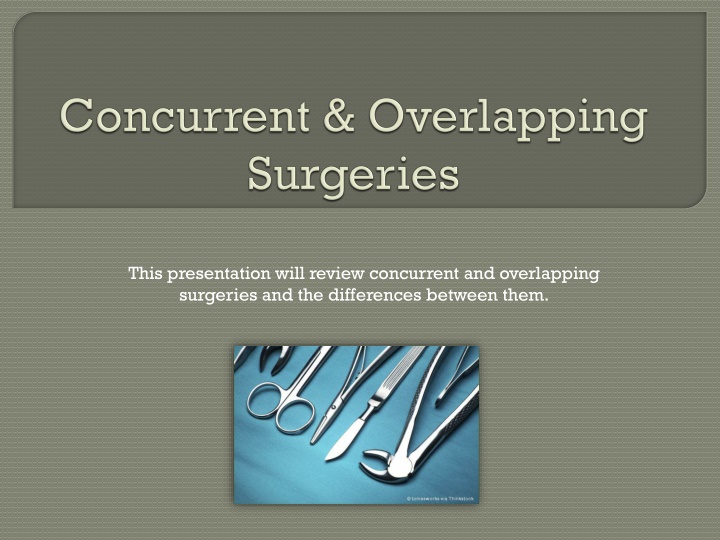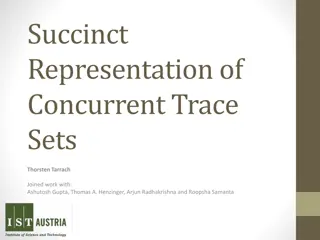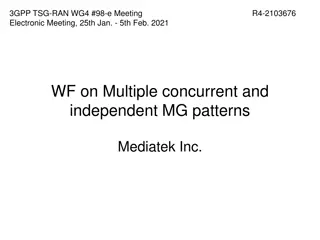Concurrent and Overlapping Surgeries
This presentation covers concurrent and overlapping surgeries, highlighting the key differences between them. Learn about the benefits, risks, guidelines, and scenarios where overlapping surgeries may be appropriate in the medical field.
Download Presentation

Please find below an Image/Link to download the presentation.
The content on the website is provided AS IS for your information and personal use only. It may not be sold, licensed, or shared on other websites without obtaining consent from the author.If you encounter any issues during the download, it is possible that the publisher has removed the file from their server.
You are allowed to download the files provided on this website for personal or commercial use, subject to the condition that they are used lawfully. All files are the property of their respective owners.
The content on the website is provided AS IS for your information and personal use only. It may not be sold, licensed, or shared on other websites without obtaining consent from the author.
E N D
Presentation Transcript
This presentation will review concurrent and overlapping surgeries and the differences between them.
Concurrent Surgeries Operations in which the critical or key components of the procedures for which the primary attending surgeon is responsible are occurring all or in part at the same time Overlapping Surgeries Operations in which the key or critical portions of the procedures are not occurring simultaneously *Key or critical portions of an operation are defined as those segments of the operation that require essential technical expertise and surgical judgment in order to achieve optimal patient outcome It is the primary surgeon s responsibility to determine which portions of the operation are critical or key Frellick, Marcia. ACS Updates Guidelines Regarding Overlapping Surgeries. Medscape, April 18, 2016.
Benefits Increased efficiencies Reduced patient wait times for surgeries Expanded patient access to in-demand surgeons Valuable training for residents Risks Increased risks for patients in the operating room More liability for the attending surgeon once they leave the operating room to begin another surgery they are still ultimately responsible for the patient Could lead to allegations of fraud if submitted claims do not accurately reflect the providers who performed the procedures
Concurrent or Simultaneous Operations A primary attending surgeon s involvement in concurrent or simultaneous surgeries on two different patients in two different rooms is not appropriate. Overlapping Surgeries Overlapping surgeries may be appropriate if key or critical elements of the first operation are finished, freeing up the primary attending to start an operation in another room while others finish the first operation. Frellick, Marcia. ACS Updates Guidelines Regarding Overlapping Surgeries. Medscape, April 18, 2016.
Overlapping of two distinct operations by the primary surgeon can occur in two general circumstances: 1) Key or critical elements of the 1st operation have been completed and there is no reasonable expectation the surgeon will return to that operating room The 2nd operation is started in another room while a qualified practitioner performs non-critical components of the 1st operation (i.e., initiating a 2nd operation during wound closure of the 1st operation) A qualified practitioner must be physically present at all times once the primary surgeon has left
2) Critical elements of the 1st operation are completed and the primary surgeon is performing critical portions of the 2nd operation in another room The primary surgeon must immediately assign another surgeon to the first OR room
The primary surgeon may delegate part of the operation to qualified practitioners including, but not limited to: Residents Fellows Anesthesiologists Nurses Physician Assistants Nurse Practitioners Surgical Assistants Another attending under their personal direction However, the primary surgeon s personal responsibility cannot be delegated. They must be an active participant throughout the key or critical portions of the operation.
The patient needs to be informed that the primary surgeon may not be in the room the whole time and the conversation must be well documented in the medical record This discussion should also include the different types of qualified medical providers who will be participating in the operation and what their roles will be
Overlapping surgeries are a common practice at teaching hospitals Medicare will pay for these types of surgeries if certain requirements are met: The teaching physician must be present during all critical or key portions of both operations The physician needs to personally document in the record that they were physically present during those critical portions When the teaching physician is not present and in another surgery they must arrange for another qualified surgeon to be immediately available to assist if the needs arises Medicare allows teaching physicians to use their personal clinical judgment to determine which portions of a procedure are critical
Brown, Rosalie. "Amid Concurrent Surgery Controversy, How Can Hospitals Respond?" From the Experts. CNA, 5 July 2016. Web. 26 Aug. 2016. "Concurrent Surgeries: What's the Line between Safe and Reckless?" Advisory Board, 29 Oct. 2015. Web. 12 Aug. 2016. Frellick, Marcia. ACS Updates Guidelines Regarding Overlapping Surgeries. Medscape, 18 Apr. 2016. Web. 15 Aug. 2016. "Medicare Claims Processing Manual." Chapter 12 - Physicians/Nonphysician Practitioners (n.d.): 160-62. 11 Mar. 2016. Web. 16 Aug. 2016. "Statements on Principles." American College of Surgeons, 12 Apr. 2016. Web. 15 Aug. 2016. Overlapping Surgeries? All Good. Concurrent Surgeries? Not So Much. JD Supra, 12 March 2020. Web. Sep. 2022.























